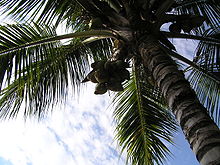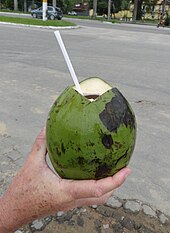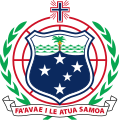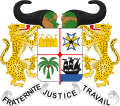Coconut palm
| Coconut palm | ||||||||||||
|---|---|---|---|---|---|---|---|---|---|---|---|---|
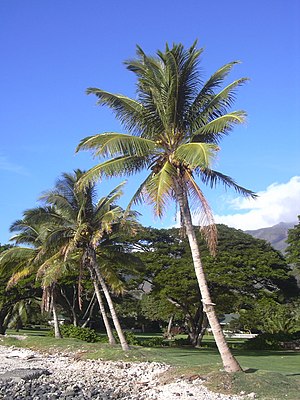
Coconut trees on Maui |
||||||||||||
| Systematics | ||||||||||||
|
||||||||||||
| Scientific name of the genus | ||||||||||||
| Coconut | ||||||||||||
| L. | ||||||||||||
| Scientific name of the species | ||||||||||||
| Cocos nucifera | ||||||||||||
| L. |
The coconut palm or coconut palm ( Cocos nucifera ) is a tropical palm family on which the coconut grows. Cocos nucifera is the only species in the genus . There are different types . Coconut palms have been grown for at least 3000 years. In 1971 the coconut palm still supplied approx. 8 percent of the world's vegetable oil requirement, in 2011, despite almost doubling production, only approx. 2 percent (see also the reference to the main article coconut oil below in the coconut oil section) . The coconut palm is also used in many other ways.
The word coconut goes back to the Spanish and Portuguese coco , to the late Latin coccus and ultimately to the ancient Greek κόκκος kókkos , which means “core” or “berry”. It has the same origins as Kokke .
meaning

In the minds of the people, no type of plant shapes the image of tropical coasts as much as coconut palms. The coconut palm has provided the inhabitants of tropical coasts with an excellent source of food and raw materials for thousands of years: with its fruits as rich food and drink (raw or fermented), its wood as building material for huts, its leaves as roofing, its fibers for weaving house walls, and baskets , Mats, ropes and the dry coconut shells as fuel. In the Indian state of Kerala , for example , a 0.2 hectare plantation with 35 palm trees already provides enough dry leaves, spathes and stone bowls to cover the annual requirement of 2500 to 3600 kg of fuel for a family of five (daily requirement 7–10 kg).
Device for scraping the meat ( East Timor )
Device for rasping out the nut from East Africa
Economical meaning
According to the Food and Agriculture Organization FAO, around 61.9 million t of coconuts were harvested worldwide in 2018 . A total of 12.4 million hectares were registered as cultivated area.
The following table gives an overview of the ten largest coconut producers worldwide, who produced a total of 89.5% of the harvest.
| rank | country | Quantity (in t) |
|---|---|---|
| 1 |
|
18,555,371 |
| 2 |
|
14,726,165 |
| 3 |
|
11,706,343 |
| 4th |
|
2,623,000 |
| 5 |
|
2,346,750 |
| 6th |
|
1,571,709 |
| 7th |
|
1,221,080 |
| 8th |
|
1,158,471 |
| 9 |
|
885.751 |
| 10 |
|
557.240 |
| world | 61.865.421 |
description
Habitus
Coconut palms are completely unbranched. Their height is fully grown between 20 and 25 meters (extreme value 30 meters). The growth starts from apex meristems that form both leaves and inflorescences . As a crested tree, the coconut palm does not form a crown, rather it has a dense crest of large leaves. A tuft consists of about 30 three to seven meter long, pinnate leaves that are divided into numerous leaf segments so that the leaves do not offer much resistance to the wind. The palm also tolerates permanent, strong sea winds and often withstands strong storms.
The greatest variety of forms can be found in Southeast Asia. These strong individual differences are used for breeding purposes. The coconut palm has a diploid set of chromosomes ; all varieties can be crossed with one another. In breeding there are also self-fertilizing dwarf forms that can be crossed with standard stems.
leaves
The crown of the evergreen plant consists of a tuft of palm-typical pinnate leaves. The length of the leaves in the adult plant varies between 3.5 and 7 meters with a width of 1 meter and a weight of 10 to 15 kg. The leaves are upright in the first year, horizontal in the second and droop in the third year before they die. Usually 12 to 19 leaves develop per year.
The pinnate leaves are divided into 200 to 250 narrow segments that are 2 to 3 cm wide and 60 to 90 cm long (the segments are not perpendicular, but angled to the leaf axis, so that despite their length, the total width of the leaf is only good 1 meter results). Young leaves are enclosed at the beginning by a leaf sheath up to 60 cm long, the brown-dried remains of which hang on the palm for a long time. These are used as "coconut fiber boards" in floristry as a substrate (not to be confused with insulation boards made of coconut fiber from peel of ripe fruit).
At the end of the segments there are joint cells that change the position of the segments in relation to the midrib and can reduce water evaporation by placing the surfaces with the stomata next to one another. The construction of the leaf allows the palm to withstand strong sea winds and most tropical storms. However, hurricanes overwhelm the performance of the coconut palm.
Inflorescences and fruit clusters
The branched inflorescences with up to 40 female and over 10,000 male flowers often grow from the leaf axes as early as the sixth or seventh year. The female flowers do not open until two weeks after the male and are receptive for about two days, so that cross-pollination predominates. Pollination is carried out both by wind and by insects (bees, wasps, beetles, ants, flies). The inflorescences, which later become stable fruit bunches, are lignified bracts called spathes . These spaths are called “coconut bowl” or “coconut leaf” in floristry and are often used.
The palm bears fruit all year round, which grow in its crown in groups of different stages of development, so that ripe coconuts constantly grow back. The coconuts are not - as the name suggests - a nut, but a stone fruit. Depending on the location, the palm trees bloom and fruit at full capacity for 15 to 60 years, but even in optimal locations they cease to produce fruit by the age of 80 at the latest. The maximum age of coconut palms is between 100 and 120 years.
The average yield is 30 to 40 ripe fruits per palm and year, in Sri Lanka 50 to 80 fruits. However, between 70 and 150 "nuts" can be harvested per year at optimal locations. In well-tended 15-year stands, around 9,500 fruits are harvested per hectare and year, in 20-year stands around 12,000 fruits.
tribe
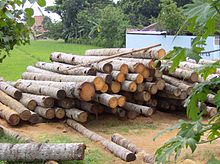
For their height of 20-25 meters, the coconut palms have surprisingly thin trunks with a diameter of 20-30 cm, but the base of the trunk is thickened to 40-50 cm. In the outer 5 cm there are brown-colored, dense fiber bundles that stabilize the trunk like ropes.
The wood is of low compressive and flexural strength. Relatively it is much more stable at the base (density, hardness, water content) than at the top, the outer area is much more stable than the inside of the trunk. This makes the palm very agile. During storms, the head shaken by the force of the wind can sway flexibly, while the base gives stability to the whole.
The density decreases in the outer trunk area (outer third) from the base to the tip from 0.9 g / cubic centimeter to 0.3 g / cubic centimeter, in the inner trunk area (inner third) from the base to the tip from 0.35 g / cubic centimeter 0.1 g / cubic centimeter.
root
From the thickened trunk base, a multitude of pencil-thick adventitious roots arise , which in adult palms extend 6 to 7 meters from the trunk and anchor it extremely well. Many palm trees even survive tsunamis . Lateral roots usually branch off almost at right angles. With this root system, the water-requiring palm mostly finds connection to the groundwater system near the coast .
Site conditions
The palm thrives particularly well on sandy loam on coasts and estuaries, and generally on all fresh, loose, nutrient-rich and deep soils. The pH value is not decisive (for example in Puerto Rico it thrives on soils with pH values of 5 to 8.0). The palm can tolerate salt water up to 0.638% (value measured in India).
Flooded or solidified soils are unsuitable. Dry, light sands are not very suitable. They lack the nutrients and water that the coconut palm needs. Lime is beneficial, the potash supply is important. Today palm plantations are also possible on nutrient-poor soils through fertilization.
distribution
The coconut palm places high demands on heat and is sensitive to frost. It is a palm of the warm, humid tropics and - apart from plantings outside the natural range (such as the Canary Islands) - only produces fruit between the 26th degree south or north latitude.
The main distribution area and the main cultivation areas are between 15 degrees south and 15 degrees north and have an average annual temperature of 27 degrees Celsius. In addition, the mean temperature of the coolest month must not be below 20 degrees Celsius. The palm needs a lot of water and thrives in areas with precipitation values of 1000 to 5000 mm per year. The optimum, as can be seen from the fruit formation, is 1200 to 2300 mm. An even distribution of the precipitation is favorable, whereby shorter dry periods are endured. However, when these reach 5-6 months, the fruit set goes back to years. Coconut palms suffer from very dry, warm winds. Coconut palms are plants that need light, only young palms can tolerate partial shade. When rearing young palms, shading is deliberately done and watered when it is dry.
Coconut palms are cultivated in the entire tropical belt , for example in the tropical regions of Asia - the Philippines , Indonesia , Sri Lanka and South India - as well as in Africa and along coasts and rivers in South America . On rivers they extend up to 150 km inland. The spread took place partly naturally, partly through humans. The original home of the coconut palm extends from continental Southeast Asia to Indonesia and the Indian subcontinent . Fossil finds from the Miocene in New Guinea and Australia make it seem plausible that the area of origin is to be found in the area of the Sunda Archipelago or in Melanesia .
Coconuts can be driven long distances across the sea and, when washed ashore, take root. There are reports that individual coconuts have even reached Scandinavia. Some coconuts that had been driven far across the sea were supposedly still germinable afterwards. However, the fruit does not last indefinitely in salt water. It has been proven that after 100 days in salt water there is still no impairment of the germination capacity.
The species spread beyond Southeast Asia and India, probably largely through humans. Even the Polynesian seafarers brought coconuts and their other food plants and livestock when they settled the Pacific islands . Austronesian settlers introduced the coconut palm to Madagascar , Arab and Persian sailors brought it to the East African coasts. The coconut palm reached the American continent very late. It may have reached the Pacific coast of Panama by itself or it may have been introduced by Polynesian sailors. European seafarers eventually introduced them to the Caribbean and the Pacific coast of the rest of Central America.
coconut
construction
Coconut is the fruit of the coconut palm and not a real nut , but a solitary stone fruit . It consists of three intergrown carpels ( synkarp axil) - hence the often slightly triangular shape of the coconut. The actual seed is covered by a thick fiber layer made of a leathery outer layer ( exocarp ), an initially fleshy, then fiber-rich, air-containing mesocarp and a very hard, 5 mm thick inner shell ( endocarp ). The 20 to 30 cm long fruit weighs between 900 and 2500 grams when ripe.
The three points that you see on one side are the three germ holes, with only one germ starting to grow. The two inactive germ holes harden.
Harvesting the coconut

Coconut palms provide full yield from the twelfth harvest. The older and taller the palm trees, the more difficult and unprofitable the harvest becomes. The coconut is harvested as a green, relatively immature, triangular, slightly larger than head-sized fruit.
The harvest is mainly done from the ground by knives on stems several meters long or by climbing up. In Thailand, Malaysia and Indonesia trained macaques are used, which climb the trees and are made to turn the nut around its own axis until it falls from the palm. The monkeys have a close relationship with their owner. Their training is difficult, as not only how to turn the nut has to be learned, but also body movements after shouting, which enable the owner to direct the leashed monkey in the tangle of branches in such a way that it does not get caught and wait upstairs for its rescue got to. If this happens, the monkey loses interest in the nut harvest, which for him is a kind of game. Good harvest monkeys represent a considerable value for the local population, which is comparable to owning a working elephant . The playful animals cost less to maintain, but require constant activity and are therefore kept in a domestic environment.
The fiber layer is removed before export in order to save transport space. Coconuts do not ripen after they are harvested; they are classed as non-climacteric fruits .
Pulp, copra
The hollow core of the coconut is lined with a white, aromatic-tasting pulp 1 to 2 cm thick, which is firm and fibrous and can be eaten raw. From a biological point of view, the pulp and coconut water form the so-called endosperm .
On the coasts of India, Burma, Indonesia and the Pacific islands, the coconut pulp is the main food. 100 g of fresh pulp contains:
| energy | water | fat | protein | sugar | Fiber | potassium | Calcium | magnesium | vitamin C |
| 1,498 kJ (358 kcal ) | 45 g | 36 g | 4 g | 4.8 g | 9 g | 380 mg | 20 mg | 39 mg | 2 mg |
The fresh pulp contains around 45% water, with a maximum of around 50%. Drying reduces the water content of the pulp to 5%. One then speaks of copra . The fat content is then 63 to 70%. A single palm provides between 5 and 20 kg of copra per year.
Copra is used as a raw material for the production of coconut oil, coconut fat, margarine , dried coconut flakes and as a paste that is used for cooking. Rasped copra is used in the confectionery industry. But mainly coconut oil is obtained by pressing the copra. The pressed residue full of sugar, protein and minerals is a valuable fodder .
Coconut oil
Coconut oil or coconut oil, also known as coconut fat, is a white to whitish-yellow vegetable oil that is solid at room temperature and is obtained from copra . It is characterized by a very high proportion of saturated fatty acids and is rich in caprylic , lauric and myristic acids . It smells mild, waxy and fresh with a slight coconut note and often slightly rancid, which is why it is always deodorized before consumption . To obtain coconut oil, copra is crushed, dried and pressed in oil mills .
Coconut oil is mainly used in the kitchen for baking, frying and deep-frying , as well as in the confectionery industry, for pharmaceutical and cosmetic purposes and as a raw material for oleochemicals . Because of the high content of lauric acid, coconut oil is an important raw material for surfactants . The production of biofuels (especially biodiesel ) from coconut oil is also possible.
Eight percent of the vegetable oil consumed worldwide is coconut oil. Important producers are the Netherlands, France and Germany, who import copra as a raw material. The USA mainly imports coconut oil.
Coconut water
When the coconuts are still green, there is up to a liter of sweet, almost clear liquid in the cavity, which is called coconut water. To get to the coconut water, the active, softer germ hole is opened. The coconut water is germ-free as long as the nut remains closed and contains almost no fat. It becomes less with increasing ripeness, but it is not completely consumed until germination. Freshly harvested coconuts contain more coconut water than coconuts that have been stored for longer. Richer in coconut water than green-skinned coconuts is the yellow-skinned "King Coconut" ( Cocos nucifera 'King', also called "Thambili" in Sri Lanka ), which was artificially selected as a drinking coconut .
In the growing countries, the coconut water from the less ripe fruits is an important substitute for drinking water and is often offered as street food . On islands without springs, three to six coconuts per person per day are needed to cover the fluid requirement. It is common to supply the fluid requirements with coconut water, for example on the Moluccas and Carolines . It is either drunk raw or fermented into coconut wine. The fermented juice has a bitter taste. A brandy is also distilled from the fermented coconut water.
Under emergency conditions, the sterile and isotonic coconut water has been used intravenously as an infusion solution for the treatment of volume deficiency shock . In some countries, coconut water is traditionally used to balance diarrhea. However, due to the low salt and glucose content, it does not comply with the oral rehydration solution recommended by the WHO .
Coconut milk
Coconut milk is not created in the nut, but is made by pureing the pulp with water and then squeezing the mixture through a cloth. The result is an aromatic, milky liquid with a fat content of around 15 to 25%, depending on the amount of water used. The remaining fibrous mass is extracted again with boiling water and pressed, which results in a thinner coconut milk. The remainder is used as protein-rich animal feed. Coconut milk is produced on a small scale in the growing countries and is exported worldwide in canned or as ultra-high- temperature coconut milk. It is used in numerous dishes ( rendang ), sauces such as sajoer and soups. In cocktails like the Piña Colada or the Batida de Coco , on the other hand, you use Cream of Coconut , a mixture of coconut milk and coconut fat that is thicker and creamier.
Unlike animal milk, coconut milk cannot be permanently homogenized because of its high fat content . The fat and water components therefore naturally separate from one another in the packaging and must be mixed again by shaking or stirring before use, if necessary. This is known and accepted in the growing countries; In the case of coconut milk sold in Western countries, emulsifiers , stabilizers and / or thickeners are sometimes added to counteract this self-segregation.
In a decision published by the European Commission (EU Official Journal), it lists foods that - contrary to the protection of names for milk - can still be designated as milk because they are traditional foods. In addition to coconut milk, this also includes fish milk and Liebfrauenmilch . “Soy milk” and comparable products made from cereals (oats, wheat, rice) or almonds may not contain the word “-milk” as milk substitute products.
The coconut water or juice that is inside unripe fruits is also mistakenly referred to as “coconut milk”.
Stone bowl
Drinking vessels, bowls, jugs, cups, spoons and vases can be made from halved coconut shells (inner stone shells). Crafts such as carvings, toys and bags are also made from the shells.
The Persian dervishes owned begging bowls ( kashgul ), which were made from coconuts washed up from the Seychelles on the beaches of the Persian Gulf and were often decorated with carved texts from the Koran and other poetry.
Especially in Southeast Asia, spit lutes are widespread, the resonance body of which consists of half a stone bowl that is polished smooth and covered with animal skin. These include the two-stringed spiked fiddle rebab , which is derived from the oriental rabāb and has reached Lombok . In Thailand there is the two-stringed spiked fiddle sor u made of an oval stone bowl and the three-stringed fiddle sor sam sai , which has an unusual, triangular body. The shell of a coconut is soaked in oil and placed in a press until the desired shape is created. In China, two spiked fiddles have a body made from a coconut shell: the two-stringed banhu in the north and the two-stringed yehu in the south. Related gauntlets in India are the ravanahattha and the pena . In Africa there are a few lute instruments with coconut shells, for example the two- to four-string plucked lotar (a scaled-down gimbri ) among the Berbers in Morocco.
The empty bowls provide high-quality fuel (also for drying the copra or simply for cooking food), which is particularly popular as charcoal . In addition to being refined into charcoal, activated charcoal can also be obtained from the shells .
For several years, especially in Sri Lanka, outer skins and fibers have been ground after drying, mixed with liquid mineral fertilizer and then pressed into blocks. These are mainly traded in Europe as so-called Cocobricks or Cocoslabs. When soaked in water, these swell up to ten times their volume and result in a plant substrate that is beneficial in many ways.
Coconut fiber
Coconut fibers are extracted from the mesocarp of unripe fruits, which can be spun into yarn . These are fiber bundles that are separated from the surrounding tissue by pectin breakdown by microorganisms. To do this, the mesocarp is first detached from the stone core and then stored in water for several months to rot the pectin (called "roasting"). The brackish waters of lagoons have proven their worth. Today, however, tanks are widely used. After this "roasting process", the fibers are traditionally loosened by tapping (today by machine) and sorted by color and fineness while still moist. They consist of 45% lignin and 44% cellulose . Coconut fibers are traded under the name Coir. After spinning, they are used to produce ropes , mats, carpets and wall coverings. The center of the coconut fiber industry is Sri Lanka.
Fibers from ripe and fully ripe fruit have a higher proportion of wood, so they cannot be spun and are used as filling material for mattresses and upholstery or for thermal insulation. All coconut fibers can be pressed in vehicle construction , for floor mats, hats, baskets, carpets, mattress fillings, handicrafts and for thermal insulation.
Open the coconut
Opening a coconut by sawing it open is a complex and comparatively injurious method. Instead, hit the nut once around along an imaginary line with a hammer, the back of a kitchen knife or a machete. After a few blows, a crack will usually open and the nut can be pried open. If the coconut water is to be collected, the active, softer germ hole must be opened with a pointed object before opening.
Other uses of the coconut palm
Wood
The wood of the trunks of the coconut palm has always been used to build huts. Since it easily rots when it comes into contact with water, elevated constructions are recommended. Since the invention of the high-performance milling machine, it has also been used for house building, shipbuilding , for seating and reclining furniture , household items (bowls or the like) and carving. It is difficult to work with by hand because it is very fibrous.
Palm fronds
The leaves are tied together to make brooms or used as roofing. They were woven (and are still occasionally used today) as house walls or baskets.
Palm wine, palm sugar, palm leaves
The vitamin B-rich juice of the palm (bleeding juice), also known as palm nectar, which is mainly obtained from the inflorescence, is fermented into palm wine or consumed as palm sugar . Palm wine and palm sugar are also made from other types of palm.
Palm wine is also used to make palmessig, which is either created spontaneously by wild acetic acid bacteria or, in the more professional production, by adding appropriate cultivated cultures. Sometimes palm wine is distilled into arrack .
The production of palm wine from the bleeding sap of the inflorescences was introduced by the Filipinos . Palm wine was exported to Mexico on Spanish ships and is still a popular drink there today.
Curiosities
The coconut is one of the fruits that palm thieves (also called coconut crabs) eat. With a body length of up to forty centimeters and a wingspan of up to one meter, it is the largest of all land crabs. The largest specimens are able to open coconuts at the germination holes.
In 1984, the doctor Peter Barss published a study on "injuries due to falling coconuts" in the journal The Journal of Trauma . Due to the weight of the coconut and the speed it gains when it falls, it exerts a weight on impact that corresponds to over a ton of mass. For this research he was awarded the Ig Nobel Prize in Medicine in 2001. Referring to his research, it was claimed that 150 people die from coconuts worldwide each year.
The sect founder August Engelhardt (1875–1919) took the view in German New Guinea that the consistent consumption of coconuts makes people immortal and leads to union with God ("Kokovorism").
Palms are dying
Since the 1980s, is the world - but especially in the Caribbean (death of the coconut trees - English yellowing lethal lethal yellowing ' ) to observe that possibly by microbes caused to be transmitted by insects.
Palm trees in heraldry
Coconut palms appear in heraldry ; their use mostly indicates their regional importance.
literature
- Jutta Beate Engelhard, Burkhard Fenner: Who has the coconut ...? The coconut palm - tree of a thousand possibilities (= Ethnologica. NF Bd. 21). Society for Ethnology, Rautenstrauch-Joest-Museum, Cologne 1996, ISBN 3-923158-30-0 .
- Gunther Franke (Ed.): Useful plants of the tropics and subtropics. Volume 1: Plants that provide luxury foods. Rubber and rubber-producing plants, oil and fat-producing plants, tubers and root crops. Hirzel, Leipzig 1967.
- Sabine Krist, Gerhard Buchbauer, Carina Klausberger: Lexicon of vegetable fats and oils. Springer, Vienna et al. 2008, ISBN 978-3-211-75606-5 , pp. 208-213
- Peter Schütt : World Economic Plants. Origin, cultivation conditions, biology and use of the most important agricultural crops. Paul Parey, Berlin et al. 1972, ISBN 3-489-78010-8 .
- Hilke Steinecke: Introducing important tropical crops. No. 15 The coconut palm: tree with 1000 uses. In: Matthias Jenny (ed.): Tropical crops from pineapple to cinnamon (= The palm garden. Special issue 30). Palmengarten of the City of Frankfurt am Main, Frankfurt am Main 1999, ISBN 3-931621-06-5 , p. 75 ff.
Web links
- Information on Cocos nucifera (English)
- Spice pages: coconut (formerly at uni-graz.at)
- Care and maintenance of coconut palms in the temperate climate zone (Central Europe ...)
- Literature (english)
Individual evidence
- ↑ See Duden online: Kokosnuss und Kokke
- ↑ a b Crops> Coconuts. In: Official FAO production statistics for 2018. fao.org, accessed on March 2, 2020 .
- ↑ Rolf Goetz: Flora of the Canary Islands: With GPS data on plant locations for download. "Rother Naturführer" series, Bergverlag Rother, Munich 2017, ISBN 978-3-7633-6102-1 . P. 194.
- ^ Bee F. Gunn, Luc Baudouin, Kenneth M. Olsen. Independent Origins of Cultivated Coconut (Cocos nucifera L.) in the Old World Tropics. PLoS ONE, 2011; 6 (6): e21143 doi: 10.1371 / journal.pone.0021143
- ↑ King Coconut (Thambili) ( Memento of the original from July 1, 2012 in the Internet Archive ) Info: The archive link was inserted automatically and has not yet been checked. Please check the original and archive link according to the instructions and then remove this notice.
- ↑ Darilyn Campbell-Falck, Tamara Thomas, Troy M. Falck, Narco Tutuo, Kathleen Clem: The intravenous use of coconut water. In: The American Journal of Emergency Medicine. Vol. 18, No. 1, 2000, ISSN 0735-6757 , pp. 108-11, PMID 10674546 , doi: 10.1016 / S0735-6757 (00) 90062-7 .
- ↑ U. Fagundes Netoa, L. Francoa, K. Tabacowa, NL Machadoa: Negative findings for use of coconut water as an oral rehydration solution in childhood diarrhea. In: Journal of the American College of Nutrition. Vol. 12, No. 2, 1993, ISSN 0731-5724 , pp. 190-193, PMID 8463517 , doi: 10.1080 / 07315724.1993.10718301 .
- ↑ J. Yartey, EK Harisson, LA Brakohiapa, FK Nkrumah: Carbohydrate and electrolyte content of some home-available fluids used for oral rehydration in Ghana. In: Journal of Tropical Pediatrics. Vol. 39, No. 4, 1993, pp. 234-237, PMID 8411318 , doi: 10.1093 / tropej / 39.4.234 .
- ↑ Regulation (EU) No. 1308/2013 of the European Parliament and of the Council of December 17, 2013 (Annex VII) , accessed on November 21, 2019 The regulation expressly states: The term "milk" is only intended for the or multiple milking, reserved for normal udder secretion, without any addition or withdrawal. Therefore, products in the trade z. B. sold as "almond drink" or "almond drink" or similar.
- ^ Peter Lamborn Wilson , Karl Schlamminger: Weaver of Tales. Persian Picture Rugs / Persian tapestries. Linked myths. Callwey, Munich 1980, ISBN 3-7667-0532-6 , p. 15.
- ↑ Michael Carus, Christian Gahle, Cezar Pendarovski, Dominik Vogt, Sven Ortmann, Franjo Grotenhermen, Thomas Breuer, Christin Schmidt: Study on the market and competitive situation for natural fibers and natural fiber materials (Germany and the EU) (= Gülzower specialist discussions. 26, ZDB -ID 2049952-8 ). Fachagentur Nachwachsende Rohstoffe e. V., Gülzow 2008, p. 126, download (PDF; 3.9 MB).
- ↑ Peter Barss: Injuries due to falling coconuts . In: The Journal of Trauma , November 1984, pp. 990f
- ↑ Christoph Drösser : Are more people killed by falling coconuts than by sharks? Zeit Online, March 26, 2014
- ↑ Palms: Deadly yellowing . In: Der Spiegel . No. 46 , 1990, pp. 328-331 (on- line ).



